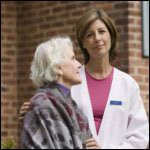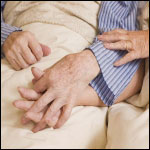May is National Stroke Awareness Month
 Stroke is the third leading cause of death in the United States. It is also a leading cause of serious long-term disability. While most strokes occur in people aged 65 years and older, strokes can occur at any age. Learn the signs and symptoms and how you can lower your risk for stroke.
Stroke is the third leading cause of death in the United States. It is also a leading cause of serious long-term disability. While most strokes occur in people aged 65 years and older, strokes can occur at any age. Learn the signs and symptoms and how you can lower your risk for stroke.
 Stroke strikes fast. You should too. Call 9-1-1 immediately.
Stroke strikes fast. You should too. Call 9-1-1 immediately.
New treatments are available that can reduce the damage caused by a stroke for some victims. But these treatments need to be given soon after the symptoms start.
Knowing the symptoms of stroke, calling 9-1-1 right away, and getting to a hospital are crucial to the most beneficial outcomes after having a stroke. The best treatment is to try to prevent a stroke by taking steps to lower your risk for stroke.
Know Your Signs and Symptoms
A stroke, or cerebrovascular accident, occurs when the blood supply to the brain is cut off (an ischemic stroke) or when a blood vessel leading to or within the brain bursts (a hemorrhagic stroke). Without oxygen, brain cells begin to die. Death or permanent disability can result.
With timely treatment, the risk of death and disability from stroke can be lowered. It is very important to know the symptoms of a stroke and act right away.
The National Institute of Neurological Disorders and Stroke notes 5 major signs of stroke:
- Sudden numbness or weakness of the face, arms, or legs.
- Sudden confusion or trouble speaking or understanding others.
- Sudden trouble seeing in one or both eyes.
- Sudden trouble walking, dizziness, or loss of balance or coordination.
- Sudden severe headache with no known cause.
All of the major symptoms of stroke appear suddenly, and often there is more than one symptom at the same time.
If you think someone is having a stroke, you should call 9-1-1 or emergency medical services immediately. Receiving immediate treatment is critical in lowering the risk of disability and even death.
Quick Facts
- Stroke is the third leading cause of death in the United States. More than 143,579 people die each year from stroke in the United States.
- Stroke is a leading cause of serious long-term disability.
- About 795,000 strokes occur in the United States each year. About 610,000 of these are first or new strokes. About 185,000 occur in people who have had a stroke before.
- Nearly 75% of all strokes occur in people aged 65 years and older. The risk of having a stroke more than doubles each decade after the age of 55.
- Strokes can—and do—occur at ANY age. Nearly 25% of strokes occur in people younger than age 65.
- Stroke death rates are higher for African Americans than for whites, even at younger ages.
- According to the American Heart Association, stroke will cost almost $68.9 billion in both direct and indirect costs in 2009 (American Heart Association. Heart Disease and Stroke Statistics—2009 Update. American Heart Association; 2009).
- It has been noted for several decades that the southeastern United States has the highest stroke mortality rates in the country. It is not completely clear what factors might contribute to the higher incidence of and mortality from stroke in this region.
- Stroke mortality in Oregon rivals that in the Southeast.
Healthy Lifestyle Choices Can Lower Your Risk
 All people can take steps to lower their risk for stroke, whether they have had a stroke or not. Things you can do to lower the risk of stroke include steps to prevent and control high blood pressure, heart disease, and other chronic conditions, eating a healthy diet, maintaining a healthy weight, exercise, and not smoking.
All people can take steps to lower their risk for stroke, whether they have had a stroke or not. Things you can do to lower the risk of stroke include steps to prevent and control high blood pressure, heart disease, and other chronic conditions, eating a healthy diet, maintaining a healthy weight, exercise, and not smoking.
- Prevent and control high blood pressure. See CDC’s high blood pressure fact sheet.
- Prevent and control diabetes. See CDC's diabetes program Web site.
- Stop smoking. See CDC's tobacco intervention and prevention source Web site.
- Treat atrial fibrillation. See CDC’s fact sheet about this condition.
- Prevent and control high blood cholesterol. See CDC’s cholesterol fact sheet.
- Use alcohol moderately. Visit CDC's alcohol and public health Web site.
- Maintain a healthy weight. Visit CDC's nutrition and physical activity program Web site.
- Be physically active. See CDC's nutrition and physical activity program Web site.
- Eat a healthy diet. See CDC's nutrition and physical activity program Web site.
- Know your family history. Visit CDC's genomics and disease prevention Web site.
Podcasts Related to Heart Disease and Stroke
- A Cup of Health with CDC—Common Killers
The first and third leading causes of death in the United States are heart disease and stroke. Dr. Mary George discusses these conditions and how to avoid them. (Oct 2008) ( 4:20 mins)
4:20 mins) - A Minute of Health with CDC—Common Killers
This broadcast discusses heart disease and stroke, the first and third leading causes of death in the United States, and how to prevent them. (Oct 2008) ( 0:59 mins)
0:59 mins) - A Cup of Health with CDC—Watch Those Signs
Strokes are the third leading cause of death and the leading cause of disabilities among adults in the United States. Rob Merritt discusses how to decrease the risk for a stroke and common signs and symptoms associated with this event. (May 2008) ( 3:16 mins)
3:16 mins) - A Minute of Health with CDC—Watch Those Signs
This broadcast discusses how to decrease the risk for a stroke and common signs and symptoms associated with this event. (May 2008) ( 0:59 mins)
0:59 mins)
Other Resources Related to Stroke
- The Paul Coverdell National Acute Stroke Registry
- American Heart Association

- American Stroke Association

- Brain Attack Coalition

- Centers for Medicare and Medicaid Services
- National Institute of Neurological Disorders and Stroke
- National Stroke Association

Publications
- 2008 Atlas of Stroke Hospitalizations Among Medicare Beneficiaries
The newest atlas in our series of six was developed in collaboration with the Centers for Medicare and Medicaid Services, and includes county-level maps of stroke hospitalizations by stroke-subtype, race/ethnicity, discharge status, and co-morbidity. - Atlas of Heart Disease and Stroke Among American Indians and Alaska Natives
Among American Indians and Alaska Natives, heart disease and stroke are the first and sixth leading causes of death. - Successful Business Strategies to Prevent Heart Disease and Stroke Toolkit
This toolkit provides an ideal resource for state programs to collaborate with other chronic disease partners throughout the state in developing comprehensive CVH work site programs. - Awareness of Stroke Warning Symptoms—13 States and the District of Columbia, 2005, MMWR May 2008
Current Features
Need info on a
different topic? See


